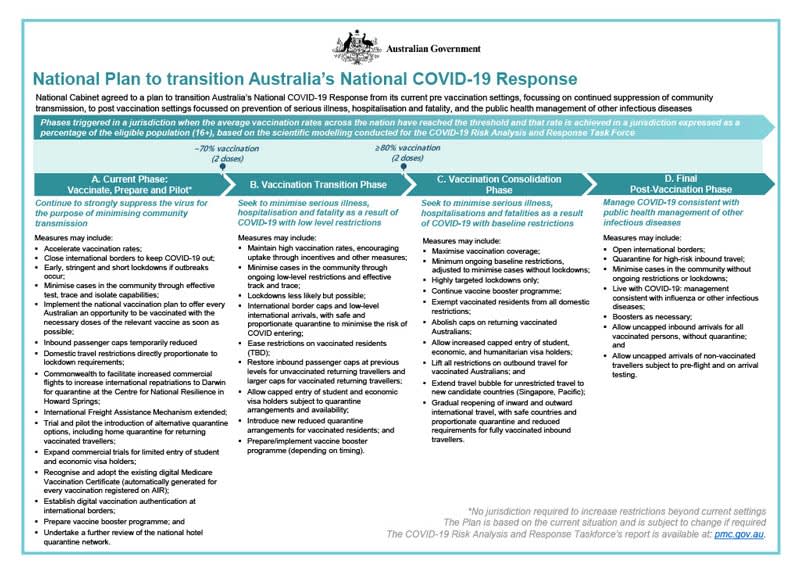With much of the country staring down the uncertain future of endless rolling lockdowns, vaccination is the light at the end of the tunnel.
The terms of engagement have shifted. While safe in our island fortress, vaccines seemed like something we could put off until absolutely necessary while the rest of the world figures out the safety profile of the various jabs available.
Absolutely necessary has now become our reality and state governments around Australia are urging people to get vaccinated with whatever jab they can get their hands on. It’s like viral Black Friday at the clinics right now.
That panic has been a great driver for vaccination rates and, while we still lag behind every single country in the developed world, we’re shooting up quickly.
Australia’s COVID-19 escape plan now has dates and numbers in the blank spaces left by 18 months of government dithering and the road to freedom, while not exactly clear, at least has a sign and a map.
Here’s what could/should/might/probably/maybe/if-the-planets-align happen when we hit certain levels of vaccination.
Australia’s COVID Vaccine Plan
The federal and state governments have agreed to a four-stage process to open up and live with COVID-19. This plan is based on modelling from the Grattan and the Doherty Institutes and has been given the all clear from the national cabinet.

Right now we’re in Phase A: ‘vaccinate, prepare, and pilot’. This is where the government plans to ‘continue to strongly suppress the virus for the purpose of minimising community transmission’
The measures here ‘may’ include accelerating vaccination rates, keeping international borders shut, deploying early lockdowns, establish international vaccine passports and prepare the vaccine booster programme.
That’s the strategy right now. When we hit 70% of everyone over the age of 16 double vaxxed, that’s when we move onto the second phase.
Phase B: Vaccination Transition Phase
The strategy at phase two is to ‘seek to minimise serious illness, hospitalisation and fatality as a result of COVID-19 with low-level restrictions’.
This is somewhat complicated by NSW Premier Gladys Berejiklian’s repeated announcements that once the state hits six million doses (not double vaccinations), restrictions could be loosened.
The Premier again stated on Thursday, August 19, rather coyly, that “once we get to six million jabs, people who are vaccinated will be able to do something they cant do right now”.
NSW is currently at five and a half million doses and six million is only around a 50% single-dose vaccination rate. Berejiklian has warned, however, that restrictions wouldn’t lift when the state hits that number, but things like vaccination passports could allow the vaccinated some limited freedoms from lockdown.
That being said, recent announcements from the Premier have cautioned that the Delta variant changes the game.
“Life will be much freer than what it is today once we get to 70 and 80%” Berejiklian said in her press conference on Tuesday.
“It doesn’t mean we’ll be completely free. It doesn’t mean that we will let the virus be rampant in the community no matter our number of cases, but it will be freer than it is today. I really want to stress that point”.
“We will need to live with restrictions so long as Delta is around,” Berejiklian has said previously.
She has also remarked that September and October would be the toughest months for the state.
Once every state and territory hits 70% fully vaccinated, the government’s measures ‘may’ include the reduced likelihood of using lockdowns to control COVID, the reintroduction of boosted international arrivals, the easing of restrictions on vaccinated people, allowing international students to return.
The timeline on when we might reach 70% varies state-to-state. Guardian data shows that Tasmania is the closest to this target and could reach it in 81 days. NSW is on track to hit 70% in 86 days, Victoria in 103 days, and South Australia trailing the pack at 109 days.
That puts us somewhere between late October and late November for reaching that target if the vaccinations continue at their current rates.
Phase C: Vaccination Consolidation
Phase C will begin when 80% of the population above the age of 16 receives both of their vaccinations.
The government’s strategy at this stage will be to “seek to minimise serious illness, hospitalisations and fatalities as a result of COVID-19 with baseline restrictions.”
When we reach that, government measures ‘may’ include minimum restrictions to manage cases without lockdowns, freedom from restrictions for all vaccinated people, unrestricted international arrivals, unrestricted international travel for the vaccinated, expanded international travel bubbles.
This is the phase we really want to get to. According to Grattan Institute modelling, opening up before 80% is really a roll of the dice. It could pay off but it could also result in overwhelming hospitalisations so it’s better if we play it safer here and not waste all the hard work we’ve done so far.
We’re scheduled to hit 80% by December 21st at the latest, based on the current rate so we could be in for a great Christmas. Tassie is again pulling ahead and could hit this by November 20. NSW is on track for 80% by November 23, Victoria December 14, and Queensland December 19.
Phase D: Post-Vaccination Phase
Phase D is basically the end date of the pandemic. This is when we start treating COVID-19 like any other infectious disease and we can finally see the back of this strange and frightening era of our lives.
There’s no vaccination rate associated with this phase but we can assume it’s above 80% for everyone above the age of 16. It could also include those from the age of 12 up, as Pfizer has now been approved for young people and the new Moderna vaccine is also set to be approved for the same age group.
Moderna is looking to trial their vaccines in children as young as six months and if this works we could see the COVID-19 jab being included in the range of vaccines you receive as a baby.
Phase D measures ‘may’ include the total opening of international borders for everyone and the introduction of booster jabs like the current flu jabs.
Tellingly, the plan also includes the need to monitor COVID-19 in the community and attempting to limit its spread without restrictions or lockdowns. It also suggests we could employ quarantine for ‘high-risk’ travellers, and pre-flight and arrival testing of unvaccinated travellers.
There’s no end date here given but we can guess that we’ll be looking at this phase by the end of the year and possibly into early 2022.
It’s worth mentioning that these are all federal targets and guidelines. States may play it differently and it’s up to them to decide when and how restrictions will be loosened. While it’s likely we will see them following the timeline of the federal government, they could also pull the trigger early if their populations are becoming disillusioned with lockdowns.
While another four-five months of this COVID nightmare seems like a lot right now, the pandemic has moved in the blink of an eye — mainly due to how our brains process memory — and sooner than we know it, COVID will be a distant memory we reminisce on down the pub and tell our grandkids about. Cheers to that.







